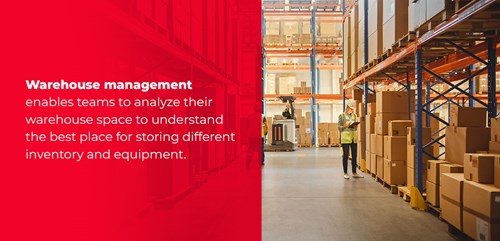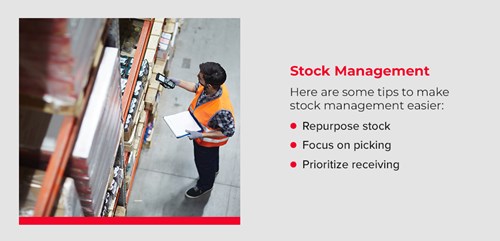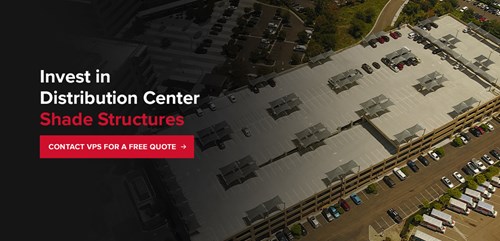Tips to Manage and Protect Warehouse Inventory
06.09.23

Warehouses and distribution centers are at the heart of many organizations. They ensure stock is stored correctly and provide a central location to dispatch customer orders. A warehouse has many working parts, from receiving and dispatch to storage and picking — every aspect is essential. Warehouse managers must also know how to protect warehouse inventory.
Proper warehouse management can help managers optimize warehouse space, streamline labor, track inventory, and improve customer satisfaction. General warehouse management, reducing stock damage, and preventing theft are also essential to ensuring an efficient and effective warehouse.
Read the full article or jump to a specific section:
- The Value of Proper Warehouse Management
- Tips for Overall Warehouse Management
- Tips for Reducing Damaged Stock
- Tips for Preventing Warehouse Theft
The Value of Proper Warehouse Management
Warehouse management is essential for tracking and monitoring stock levels, sending orders, and managing theft and stock losses through various processes. Effective warehouse management can help overcome different warehouse challenges including inaccurate inventory, inefficient labor management, and meeting seasonal demand.
The methods used in warehouse management allow for stock tracking from the moment it is delivered to the distribution center to the customer’s doorstep, especially if warehouse management is automated by using warehouse management systems (WMS).
Implementing proper warehouse management can help optimize warehouse space, streamline labor, increase stock visibility, and improve customer satisfaction.

Optimizes Warehouse Space and Flow
Regardless of the industry, the more warehouse space, the better. Warehouse management enables teams to analyze their warehouse space to understand the best place for storing different inventory and equipment. From there, they create a plan that ensures warehouse space is used effectively, allowing as much inventory storage as possible.
It can also identify areas where there is additional space available. Warehouse managers may use more space than needed when storing forklifts or specific stock, which can be freed for extra inventory. Part of this process may include changing the layout and design of the warehouse to ensure the effective use of space.
An additional benefit of optimized warehouse space is an improved flow of stock. Knowing when products come in and where they are stored allows managers to streamline their movement through warehouses, speeding up order fulfillment. And with customers focused on instant gratification and speedy deliveries, improved flow can help warehouse teams fulfill orders faster.
Increases Inventory Visibility
An important aspect of warehouse management is knowing how much stock there is and where it is stored. Proper warehouse management ensures managers have in-depth data on inventory levels and where they are. This real-time understanding of inventory helps warehouse managers keep track of stock and spot any misplaced, forgotten, or stolen stock.
Streamlines Labor
Labor can be challenging. Creating schedules and assigning tasks to the most suitable team member is critical to ensuring a warehouse operates effectively and efficiently while managing labor costs. Warehouse management aids in the optimal distribution of tasks, helping streamline labor.
In addition, warehouse management helps teams understand the ebb and flow of demand throughout the year. Warehouse managers can then schedule teams accordingly if they notice the warehouse is busier than usual during certain months, weeks, or days. This scheduling ensures warehouse teams have enough staff during busy times and aren’t overstaffed during quieter periods.
Improves Customer Satisfaction
As warehouse management streamlines many stock fulfillment and tracking processes, it makes it easier and faster for warehouse teams to pack, load, and deliver orders, allowing for on-time deliveries. There are also likely fewer mistakes with orders, especially when using a WMS.
Allowing customers to track their orders also improves customer satisfaction. Customers can monitor their order from when it is placed to when it is delivered. If there are delays, dispatch can tell customers about the cause, what is being done to resolve it, and when they can expect their deliveries. Faster deliveries, open communication, and improved tracking can help foster stronger, long-lasting relationships with clients.
Tips for Overall Warehouse Management
Developing an effective warehouse management system is vital for all industries. It can also be tricky with various factors to consider. These are some general tips on warehouse management:
- Invest in technology: Whether it's a WMS, inventory management and barcoding systems, pick-assisting equipment, or simple conveyor belts, technology can help effectively manage warehouses. Technology can also offer comprehensive insights and real-time visibility on stock.
- Focus on staff: With the right team, a warehouse can achieve great success. Focus on hiring the right candidates and try to provide a comfortable work environment and work schedule. Warehousing can be intensive — burnt-out, exhausted, and uncomfortable employees may make costly mistakes.
Here are a few more tips on warehouse organization, layout, and stock management to make warehouse management a bit easier:
Warehouse Organization
Cluttered warehouses are hard to navigate, slow down the fulfillment process, and can pose significant safety risks to staff. Keeping a warehouse clean and organized streamlines processes and makes it safer for everyone. Here are some tips on warehouse organization:
- Keep warehouses clean: Teach warehouse teams about cleaning as they go so no unattended stock or debris is lying around that can cause accidents. At the end of each day, encourage workers to return equipment to its proper place, from pens to forklifts. Knowing exactly where everything is can speed up various processes. Schedule weekly or monthly deep-cleaning depending on how tidy warehouse teams are.
- Label everything: Put labels on everything, including stock, different warehouse sections, and equipment. If it is in the warehouse, it should probably be labeled. Labels make finding stock quick and easy, speeding up orders. Using shelf and product barcodes or labels can also speed up stock takes and improve stock monitoring.
- Organize stock placement: Identify different types of stock, from the fastest moving and highest return items to the slowest movers. Putting the fastest-moving stock closer to dispatch can speed up packing. Remember that product popularity may change depending on the season. Try to keep similar items together, especially if they are usually ordered together.
Warehouse Layout
A warehouse's layout can significantly impact workers' efficiency and safety. It can also affect how much space is available to store stock. Here are some tips on warehouse layout:
- Consider flow: Having clear paths from receiving to storage, packing, and dispatch makes it easier for workers to travel between the different sections. Think about how to set up shelves and different areas in a way that is the fastest and easiest for teams to navigate. Ask the warehouse team for input on what would work best for them.
- Have workstations: Having multiple workstations throughout a warehouse ensures teams can access the necessary equipment, helping them work more efficiently. They can also prevent injuries as employees have dedicated spaces designed specifically for their work, limiting teams setting up in areas not suited for their tasks.
- Use zones: Create different zones based on how inventory needs to be picked and assign a team to each section. Zones can speed up picking as employees stay in one area with all the necessary equipment. A picking bin can travel between sections to fulfill an order.
- Ensure easy product access: Putting as much inventory on a shelf as possible can be tempting. Putting too much stock on shelves can impact fulfillment speed as employees spend more time searching for items and finding the safest way to remove them, so place products in an accessible way. Also, ensure the warehouse aisles are wide enough for staff and equipment to move around safely.
- Think tall: Where possible, use vertical storage. Vertical storage allows warehouse managers to maximize the amount of space they have without having to expand their warehouse.

Stock Management
The biggest element of warehouse management is stock management. It's best to remain flexible when dealing with stock, as demand naturally rises and falls throughout the year. Here are some tips to make stock management easier:
- Repurpose stock: Slow-moving or dead stock can be repurposed in a few ways to save money and create space. Use slow-moving and dead stock as freebies with other deliveries or create product bundles and add these forgotten lines. Repurposing stock is especially useful when product lines are discontinued.
- Focus on picking: Use the proper picking methods and types for the warehouse. Assess whether single or batch order picking works better for the warehouse or maybe a combination of the two. Constantly evaluate picking strategies based on customer demand and inventory to ensure a streamlined fulfillment process.
- Prioritize receiving: An important aspect of accurate stock tracking is ensuring inventory is received and stored correctly. Implement clear receiving policies to ensure inventory is packed away as soon as it arrives to help eliminate forgotten or lost stock.
Tips for Reducing Damaged Stock
Damaged stock is inevitable in many warehouses and distribution centers. Stock can get dropped, knocked over, damaged by the weather, or fall off a pallet. The key is to focus on reducing the amount of damaged stock in a warehouse by training staff on properly handling inventory and finding ways to protect it. As an additional benefit, many protective measures for stock can improve the safety of a warehouse.
Here are a few ways warehouse managers can keep inventory safe:
Train Staff on Stock Handling
Properly training warehouse staff on the correct ways to handle, store, and transport stock can help limit item damage. Regular training on loading, unloading, stacking, and securing inventory can ensure stock is handled carefully. For example, knowing how to store perishable and fragile items can lower the risk of spoiled food or broken goods.
It's vital that warehouse teams know how to load and transport goods. Forklift drivers should know how many stacks they can carry, how high the forklift can move the items, and the best way to place pallets without breaking anything.
In addition to regular training, labels, and notices throughout a warehouse remind workers of the need for safe and careful handling.
Weatherproof Distribution Centers
Hail, snow, and sun can cause significant damage to inventory. Ensure distribution centers are set up to help protect inventory from the elements, including enough shade to help prevent sun damage.
Remember to ensure the loading and unloading docks are also protected. Shade structures can provide trucks, trailers, drivers, and inventory some protection from the elements, mainly the sun. They can also help protect staff and inventory from hail and snow. This additional protection can make unloading and loading inventory more efficient. Further, shade structures can be multipurpose. Adding solar panels can help reduce energy bills and improve energy efficiency.
Use the Right Equipment and Tools
It's crucial to use the right equipment when handling inventory. Using equipment that is the incorrect size or not powerful enough to move stock can damage items if they're dropped or knocked into shelves and other equipment. Shelf containers are an effective way to protect goods. They can also make organization easier.
Invest in protective equipment like racking protectors, aisle shields, and support bars to create safe and durable racks. Stretch wraps and safety straps help ensure stock is secure and reduce dropped stock.

6 Tips for Preventing Warehouse Theft
Theft is an unfortunate reality in many industries, including warehousing. Whether the theft occurs due to internal or external forces, warehouses and distribution centers can take steps to address the problem:
- Limit access: Only allow employees to access the required areas and software to perform their duties. This can include creating physical barriers between receiving and dispatch areas and limiting access to specific software that monitors inventory levels. Limiting access is critical if a warehouse has a lot of seasonal workers. Ensure staff still have adequate access to areas and information needed to perform their jobs properly.
- Implement security measures: Cameras, credential badges, and alarm systems can make warehouses safer. Credential badges can also limit access to certain sections or areas and track employees’ movements if there is a problem.
- Track inventory: Track more than inventory numbers — monitor how it moves through a facility and who is moving it. Warehouse managers can track where the theft might have occurred if something goes missing.
- Perform regular stock takes: Ensure stock takes are more frequent. Annual stock takes are too infrequent to show when stock goes missing, so consider doing a stock take once a month or every two months. This frequency will give warehouse managers a more in-depth understanding of their stock levels and any lost inventory.
- Have a company theft policy: A well-defined theft policy should include how a company deals with violations and an anonymous way for employees to report suspicious activity. If managers encounter employee theft, they should follow the company policy to show employees theft is taken seriously. Try to tackle any incidents of theft as quickly as possible.
- Understand the motivation behind theft: Knowing why staff are stealing can help companies manage the issue more effectively. Employees steal for a few reasons — they may struggle financially or take the opportunity when it presents itself. Once a warehouse manager knows why employees are stealing, they can take steps to curb theft in their facility.
Invest in Distribution Center Shade Structures
Shade structures are a simple and effective way to help protect inventory as it moves in and out of distribution centers or warehouses. They can help shield stock from wind, hail, and sun damage while providing a shaded space for trucks and trailers to wait while loading or unloading.
At VPS, we understand the importance of protecting inventory and teams while they work. Our shade structures are tailored specifically for commercial and industrial applications, and every installation is designed to fit the facility's unique requirements.
Contact us today to learn more about the benefits of our shade structures or request a free quote.
